In 1789 Lavoisier turned the concept of “element” on its head when he proposed that water was a compound and that hydrogen, oxygen, carbon, sulfur, iron, copper, and 25 other substances were the true elements. Lavoisier’s list was composed of a medley of “simple substances” (as he called them) which he organized into four categories: basic elements (gases), metals, nonmetals, and earths. However, scientists are forever searching for fundamental order and patterns, and as additional elements were discovered, trends were observed. Johan Wolfgang Döbereiner (1780-1849) in 1829 of the University of Jena (the same university where Karl Marx studied) noticed that there were several “triads” of chemically similar elements in which the middle element had an atomic weight half-way between those of the other two elements. For example, for the alkaline earths, the atomic weight of strontium (42.5) was the arithmetic mean of calcium (20) and barium (65). These arithmetic comparisons depended upon the accurate atomic weights determined by Berzelius (discussed in a previous chapter).
Unfortunately, even though Berzelius had made very precise measurements, the valence of the elements was not well understood. Frequently the true atomic weight of an element was not certain, but instead could be a multiple or fraction of the apparent equivalent weight. In a previous chapter, we described how John Dalton, the founder of atomic theory, stated that the formula of water was HO, and that consequently the respective atomic weights of hydrogen and oxygen were 1 and 8. Amedeo Avogadro (1776-1856) in 1821 had proposed that since two volumes of hydrogen gas unite with one volume of oxygen gas, then water is composed of two atoms of hydrogen and one atom of oxygen. This recognition doubled (or even tripled) many of the atomic weights — in the case of water, giving hydrogen = 1 and oxygen = 16. However, Avogadro’s idea was a hypothesis, and not a proven theory; it was not universally accepted and much confusion remained, since variable and even multiple valences occurred for the bulk of the elements.
Before the periodic table could be formulated, true atomic weights needed to be determined, and accordingly it was necessary to know the correct valences for the elements. The watershed moment allowing the conceptualization of the periodic table was the Chemiker Kongress (Chemical Congress) of September 3-5, 1860. This international conference, held in the Ständehaus (parliamentary building, see illustration) of Karlsruhe, Germany, was organized to discuss nomenclature, notation (chemical symbols), and the vexing question of atomic and molecular weights. At the end of the conference, the Italian chemist Stanislao Cannizzaro (1826-1910; known for his eponymous organic reaction wherein an aldehyde disproportionates to an alcohol and a carboxylic acid) distributed a pamphlet describing in detail how Avogadro’s hypothesis could be “rediscovered” to establish a self-consistent set of true atomic weights. To complete his publication, he also included Dulong-Petit’s Law, which was useful for solids. According to this law, the specific heat (heat required to warm a substance by one degree) was inversely proportional to the atomic weight.
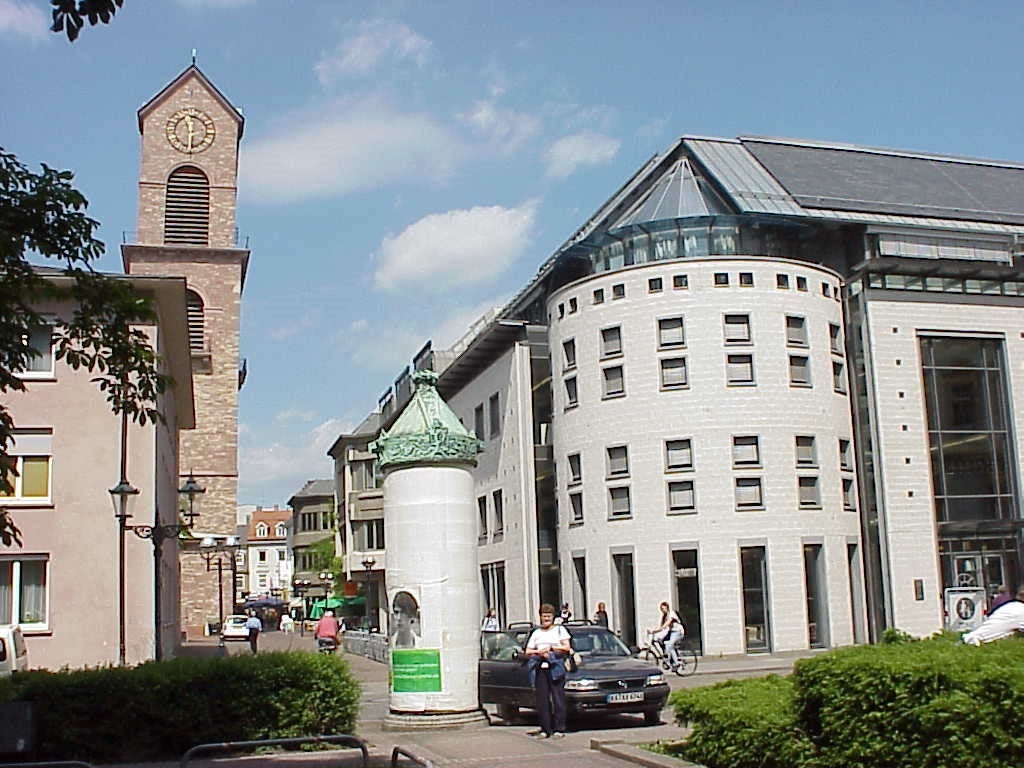 The Standehaus (parliamentary building) in Karlsruhe, Germany
The Standehaus (parliamentary building) in Karlsruhe, Germany
Two participants in the audience — Dimitri Mendeleev (1834-1907, professor of chemistry at the Saint Petersburg State University in Russia); and Julius Lothar Meyer (1830-1895, professor of chemistry in Breslau, Germany (now Wrocław, Poland)) — were quick to see how these corrected numbers allowed a new ordering of the elements. (Interestingly, both Mendeleev and Meyer had worked with Robert Bunsen, see previous article). Mendeleev later said, “I well remember how great was the difference of opinion, and how a compromise was advocated with great acumen by many scientific men. . . . In the spirit of scientific freedom. . . the truth afterwards soon convinced all minds.” Meyer said, “The scales fell from my eyes, doubts vanished, and a feeling of calm certainty came in their place.” Both scientists hastened home and independently drew up their periodic tables, using the 56 elements then known.
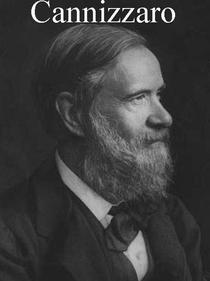 A portrait of Stanislao Cannizzaro
A portrait of Stanislao Cannizzaro
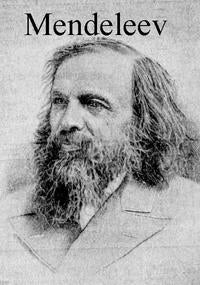 A portrait of Dmitri Mendeleev
A portrait of Dmitri Mendeleev
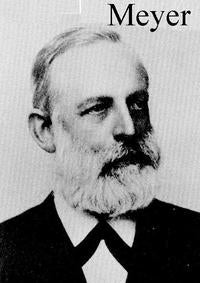 A portrait of Julius Lothar Meyer
A portrait of Julius Lothar Meyer
Even though the two respective periodic tables were essentially identical in content, Meyer’s was more cautious but Mendeleev published first. Interestingly, each scientist interpreted the significance and ultimate meaning of the table quite differently. Meyer plotted atomic weight vs atomic volume to show periodicity with six sections. Meyer proceeded to show similar behavior of melting points, volatility, malleability, brittleness, and electrochemical behavior. Mendeleev’s approach was to arrange the elements in a table reflecting periodic chemical behavior in a more descriptive manner. Mendeleev’s approach proved to be more useful in the immediate future, because it could be generalized and, as Mendeleev pointed out, it even predicted new elements! Mendeleev himself stated, “Each law of natural science is of particular value scientifically only when it is possible to draw from it practical consequences. . . . especially, which permit making predictions that can be confirmed by experiment.” Scarcely half a generation later, his words would be powerfully borne out. The table published in 1871 by Mendeleev arranged the elements on the basis of the chemistry of the elements known at that time. Mendeleev was so convinced of the reality and truth of this arrangement that he corrected the valence of beryllium from 3 (as fixed by Berzelius, who claimed beryllia had the formula Be2O3) to 2, to give the correct formula as BeO. He further assumed (correctly) that the oxide of indium was In2O3 and that the oxide of uranium was UO3. Even though Meyer admitted that Mendeleev’s approach was more powerful, Meyer viewed the periodicity of atomic volumes (i.e., sizes of atoms) as an indication of some internal structure. (This aspect could not be seriously investigated for half a century). Mendeleev believed the table could be used in a more pragmatic manner (he didn’t even believe in atoms!) — and even predicted three elements which were subsequently discovered.
At the time of the discovery of the periodic table, both Meyer and Mendeleev were regarded as codiscoverers. In recognition of this accomplishment, both were presented in 1882 with the Davy Medal in London. Mendeleev simply rose and bowed, not feeling comfortable with addressing the audience in English. Meyer then stood and gave the unpretentious words, “I am not Mendeleev. I am Lothar Meyer.” The audience gave a standing, deafening ovation for both scientists.
Mendeleev continued to work on the periodic table the rest of his life, modifying and refining it as more elements were discovered (including an entire family, the inert gases discovered by William Ramsay and Lord Raleigh in England), while Meyer turned to other areas of chemistry. Mendeleev’s correct prediction of three elements (see below) promoted his name to prominence, and today is generally recognized erroneously as the founder of the periodic table with no or little reference to Meyer.
Mendeleev’s predictions realized! Mendeleev had been so bold as to predict not only the existence of new elements — “eka-boron,” “eka-aluminum,” and “eka-silicon” — but also the properties of each. Before 15 years had passed, these elements had been discovered, with an uncanny agreement of 54 predicted atomic weights, physical properties, and chemical reactivities.
Gallium (Mendeleev’s predicted eka-aluminum) was discovered by Paul Lecoq de Boisbaudran, who used spectroscopy to ferret out a trace metal in the lead mines of southern France. For this analysis Boisbaudran had developed methods of spectroscopic analysis, and his contributions rank him with Bunsen, Kirchhoff, and Crooks as one of the founders of spectroscopy (see previous chapter). He reasoned that since most minerals had now been completely analyzed, there was little hope of finding a new mineral whose principal constituent was one of the undiscovered elements. Therefore, he concluded, the undiscovered elements would be in trace amounts, and might be best detected by spectroscopic analysis.
Scandium (eka-boron) was discovered by Lars Nilson, in conjunction with his studies of the rare earth elements. He was analyzing a sample of Scandinavian euxenite (a mixed calcium-rare earth titanateniobate-tantalate), named for its rare components (“good stranger”), and upon separating some ytterbia also obtained an unknown earth whose properties coincided precisely with those predicted by Mendeleev.
Germanium (eka-silicon) was discovered in 1886 by Clemens Winkler at the Freiberg Mining School, in a new sulfide mineral found in the Himmelfürst Mine nearby. The new mineral, called argyrodite, was analyzed and proved to possess the formula (Ag8GeS6).
Two decades after its discovery, Mendeleev’s periodic table still afforded the basic structure for the organization of the elements, but the elements in the atomic weight range of 140-180 (the rare earths) were troublesome. Trends in this range made little sense — at first, Mendeleev thought he had correctly placed cerium, erbium, lanthanum, and didymium (actually a mixture of two rare earths, praseodymium and neodymium), but with the discovery of further rare earths he gave up and omitted them from the table. A further difficulty was found when the Czech chemist Brohuslav Brauner discovered (in 1889) the true atomic weight of tellurium was 127.6, actually greater than that of iodine even though it was placed before iodine in the periodic table. Mendeleev assumed the value was incorrect — but chemical periodicity by now was deeply set in the minds of chemists, and it was becoming accepted that atomic weight was obviously not the ultimate criterion for periodicity (atomic number was not understood until Henry Moseley proposed the concept in 1912).
In Mendeleev’s last periodic table, presented in 1902, he had added a column of inert gases (discovered by William Ramsay and Lord Rayleigh during the previous decade), but he avoided the rare earths. Brauner was more ambitious; an attempt by him to create order was noble but artificial. There were still gaps in the periodic table, and it was not known how many elements should exist between barium and tantalum. This important bit of information was not learned until Moseley’s X-ray work which defined atomic numbers. Another problem — the rare earths — had to await Bohr’s theoretical work in 1922 which allowed the organization of the periodic table into s, d, p, and f blocks. The work of Moseley and Bohr then allowed a periodic table which is essentially the same as today's. Thus, Mendeleev had in a short moment in 1869 captured the extent to which chemical theory could be driven: the chemical elements could be organized according to their chemical behavior, but vagaries existed and a motley collection of rare earths defied explanation despite almost forty more years of toil by the famous Russian scientist.
A few additional elemental discoveries in the late 1800s and early 1900s generally fit nicely into gaps of the refined periodic table. By 1925 elemental fluorine was prepared in 1886 by Henri Moissan and naturally fit into the halide chemical family. The gap below zirconium was filled with hafnium by George de Hevesy and Dirk Coster in Copenhagen in 1925; the extreme chemical similarity of zirconium and hafnium had previously prevented chemists from separating and identifying the heavier element. The last naturally occurring nonradioactive element — rhenium — was found by intense chemical concentration of Scandinavian ores by the German man-and-wife research team Walter Noddack and Ida Tacke in 1925. A gap remained between manganese and rhenium, which Noddack and Tacke proposed the spurious “masurium,” but the true element was not discovered until the atomic age (see next chapter). Finally, the remaining rare earths were simply lumped together as a separate group at the bottom of the periodic table.
Five more radioactive elements were discovered in the time period before 1925 — radium, polonium, and actinium (by the Curie group in Paris); protactinium by Otto Hahn and Lise Meitner in Berlin, and Frederick Soddy and John Cranston in Aberdeen, Scotland; and radon by Ernest Rutherford and Frederick Soddy in Montreal, Canada (in older literature Friedrich Dorn is recognized as the discoverer of radon, but this is incorrect). (Uranium and thorium were also radioactive and had been previously discovered, but before the phenomenon of radioactivity was known). Radon could be placed in the inert gas family, and the remaining four elements could be easily placed in their appropriate places, it was thought, by merely continuing them beyond radium in the middle section of the periodic table, i.e., the transition elements. It was not yet known that these elements would form a second “lump” at the bottom of the periodic table below the rare earths.
A fitting memorial in Varel, Germany. On the lawn of the Lothar Meyer Gymnasium (high school), the “Three Heads” have been erected (see illustration). The statues of Cannizzaro, Mendeleev, and Meyer are facing one another in a triangular arrangement, each looking upon one another with recognition of the contributions of the others to the creation of the periodic table which endures today. Appropriately, each of the headposts are positioned to represent the respective geographical location: Meyer from the West (Varel, Germany), Mendeleev from the East (St. Petersburg, Russia), and Cannizzaro from the South (Geneva, Italy). Meyer faces the school that bears his name.
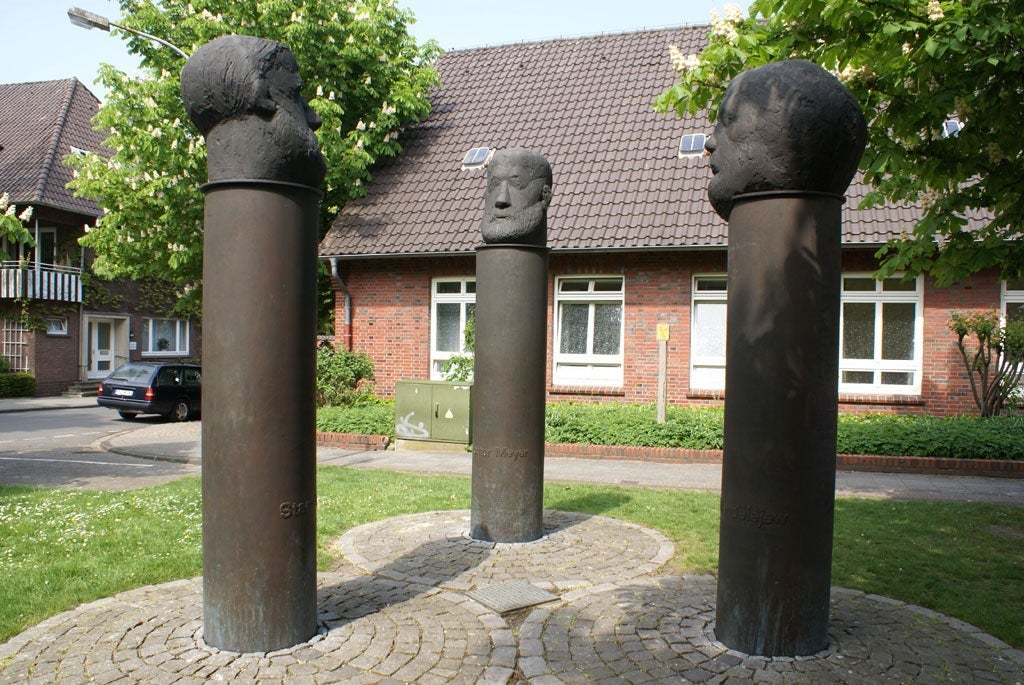
Three head posts of Cannizzaro, Mendeleev and Meyer facing each other on the courtyard of the Lothar Meyer Gymnasium (high school) in Varel, Germany.







